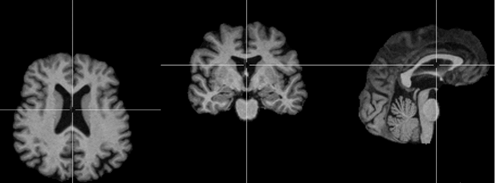Implementation of a 3D Convolutional Neural Network Predictive Model for the Transition from Mild Cognitive Impairment to Alzheimer’s Disease using Magnetic Resonance Imaging (MRI) Images
Implementación de un modelo predictive basado en redes neuronales convolucionales 3D en el paso de deterioro cognitivo leve a Alzheimer sobre imágenes por resonancia magnética


This work is licensed under a Creative Commons Attribution-NonCommercial-NoDerivatives 4.0 International License.
Copyright statement
The authors exclusively assign to the Universidad EIA, with the power to assign to third parties, all the exploitation rights that derive from the works that are accepted for publication in the Revista EIA, as well as in any product derived from it and, in in particular, those of reproduction, distribution, public communication (including interactive making available) and transformation (including adaptation, modification and, where appropriate, translation), for all types of exploitation (by way of example and not limitation : in paper, electronic, online, computer or audiovisual format, as well as in any other format, even for promotional or advertising purposes and / or for the production of derivative products), for a worldwide territorial scope and for the entire duration of the rights provided for in the current published text of the Intellectual Property Law. This assignment will be made by the authors without the right to any type of remuneration or compensation.
Consequently, the author may not publish or disseminate the works that are selected for publication in the Revista EIA, neither totally nor partially, nor authorize their publication to third parties, without the prior express authorization, requested and granted in writing, from the Univeridad EIA.
Show authors biography
Alzheimer’s disease is a neurological disorder that causes loss of autonomy and memory in people who suffer from it. Due to the increase in cases of this disease and the lack of accuracy of diagnostic tools, new tools capable of addressing this issue are being developed. The main objective of this research work is to implement a three-dimensional convolutional neural network model with AlexNet3D type base structure to predict the possible diagnosis of Alzheimer’s disease (AD). from the analysis of magnetic resonance images, using as an early stage mild cognitive impairment syndrome (MCI). The construction phases of the project will be explained, divided into database selection, feature selection, data processing, model development for training and validation, and finally, results obtained from prediction tests. With this it was possible to obtain a percentage of 72,222 %, allowing the K-Net95 model to be cataloged as a stable and efficient network, despite the computational limitations to which the project was limited.
Article visits 184 | PDF visits 131
Downloads
- Ahsan, M. M., Luna, S. A. & Siddique, Z., 2022. Machine-learning-based disease diagnosis: A comprehensive review. Healthcare, 10(3), p. 541. doi: 10.3390/healthcare10030541.
- Alom, M. Z., Taha, T. M., Yakopcic, C., Westberg, S., Sidike, P., Nasrin, M. S., Van E., Brian C., Awwal, A. A. S. & Asari, V. K., 2018. The history began from AlexNet: A comprehensive survey on Deep Learning approaches. arXiv [cs.CV]. Available at: http://arxiv.org/abs/1803.01164 (Accessed: 4 November 2023).
- Curry Jansen, S., 2021. What was artificial intelligence? mediastudies.press.
- Fischl, B., 2012. FreeSurfer. NeuroImage, 62(2), pp. 774–781. doi: 10.1016/j.neuroimage.2012.01.021.
- Ghafoori, S. & Shalbaf, A., 2022. Predicting conversion from MCI to AD by integration of rs-fMRI and clinical information using 3D-convolutional neural network. International Journal of Computer Assisted Radiology and Surgery, 17(7), pp. 1245–1255. doi: 10.1007/s11548-022-02620-4.
- Goncalves, M. O., 2019. 7 ventajas del diagnóstico temprano en la enfermedad de Alzheimer. Grupo SINAPSIS. Available at: https://www.gsinapsis.com/7-ventajas-del-diagnostico-temprano-en-la-enfermedad-de-alzheimer/ (Accessed: 29 June 2024).
- Henschel, L., Conjeti, S., Estrada, S., Diers, K., Fischl, B. & Reuter, M., 2020. FastSurfer - A fast and accurate deep learning based neuroimaging pipeline. NeuroImage, 219, p. 117012. doi: 10.1016/j.neuroimage.2020.117012.
- Kataoka, H., Wakamiya, T., Hara, K. & Satoh, Y., 2020. Would Mega-scale Datasets Further Enhance Spatiotemporal 3D CNNs? arXiv [cs.CV]. Available at: http://arxiv.org/abs/2004.04968.
- Martínez Llamas, J., 2018. Reconocimiento de imágenes mediante redes neuronales convolucionales. Universidad Politécnica de Madrid.
- Milletari, F., Navab, N. & Ahmadi, S.-A., 2016. V-net: Fully convolutional Neural Networks for volumetric medical image segmentation. arXiv [cs.CV]. Available at: http://arxiv.org/abs/1606.04797.
- Topol, E. J., 2019. High-performance medicine: the convergence of human and artificial intelligence. Nature Medicine, 25(1), pp. 44–56. doi: 10.1038/s41591-018-0300-7.
- Velazquez, M. & Lee, Y., 2022. Multimodal ensemble model for Alzheimer’s disease conversion prediction from early mild cognitive impairment subjects. Computers in Biology and Medicine, 151, p. 106201. doi: 10.1016/j.compbiomed.2022.106201.
- Weiner, M. W., Veitch, D. P., Aisen, P. S., Beckett, L. A., Cairns, N. J., Green, R. C., Harvey, D., Jack, C. R., Jagust, W., Liu, E., Morris, J. C., Petersen, R. C., Saykin, A. J., Schmidt, M. E., Shaw, L., Siuciak, J. A., Soares, H., Toga, A. W. & Trojanowski, J. Q., 2012. The Alzheimer’s Disease Neuroimaging Initiative: A review of papers published since its inception. Alzheimer’s & Dementia: The Journal of the Alzheimer’s Association, 8(1S), p. S1. doi: 10.1016/j.jalz.2011.09.172.
- Zhou, Q., Li, X., He, L., Yang, Y., Cheng, G., Tong, Y., Ma, L. & Tao, D., 2023. TransVOD: End-to-end video object detection with spatial-temporal transformers. IEEE Transactions on Pattern Analysis and Machine Intelligence, 45(6), pp. 7853–7869. doi: 10.1109/TPAMI.2022.3223955.




